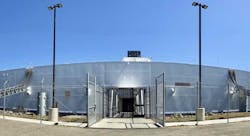Sustainable Data Center Cooling: CUE, Free Cooling, and ERE
Last week in our special report series, we explored three external heat rejection systems. This week, in our final article in the series on sustainable data center cooling challenges, we’ll discuss three more external heat rejection systems.
Carbon Usage Effectiveness
Carbon Usage Effectiveness (CUE) is another essential sustainability metric directly tied to the source of energy generation.
It is expressed as CUE Source – Based on the annualized carbon emitted by the energy source (power generation), expressed as kilograms of carbon emitted per kWh of IT Energy generated. (kg/IT kWh).
The EPA’s Emissions & Generation Resource Integrated Database (eGRID) website has a tool that allows users to enter their zip codes (or select a region) to view their power profiles.
Source: EPA
Source: EPA
Free Cooling
Free cooling is typically referred to as any type of cooling system which reduces or eliminates the need for mechanical cooling (i.e., compressor based). This can include direct or indirect air-side economizers, as well as water-side economizers. The water-side economizer is generally based on a heat exchanger which allows cooling tower water to reduce the load on water-cooled chillers during cooler weather. All of these systems generally save a percentage of mechanical cooling energy during cooler weather. Overall, free cooling is more effective in colder climates, for both air-side and water- side economizers. There are many variations and combinations of methodologies that can be combined to maximize energy effectiveness and optimize water usage over the seasons.
While water in itself is not energy, it requires energy to process and deliver clean water. This is often overlooked or ignored. However, as water shortages increase, this is being addressed in the California Energy Code: Codes and Standards Enhancement (CASE) Initiative 2022 – “Title 24 2022 Nonresidential Computer Room Efficiency” (CA-Title 24), as “Embedded Electricity in Water.”
Alternately, waste heat can also be rejected into bodies of water, such as lakes and rivers or even the ocean. In many cases, the temperature ranges of those bodies of water are such that they can be used all year round to cool data centers without the need for mechanical cooling, a significant energy savings. These savings can also reduce or eliminate consumption of source water, as well as reducing fossil fuels used in non-renewable power generation.
Energy Reuse Effectiveness
The total waste heat generated by an air-cooled or a liquid-cooled data center is virtually the same for a given amount of total energy consumed. Clearly, a lower PUE will reduce the total energy consumed for a given IT load. While end-to-end thermal management typically refers to “chip-to-atmosphere” heat rejection, it is still just waste heat. One of the long-term sustainability goals is being able to recover and reuse waste heat.
Liquid Cooling provides a pathway to more effective opportunities for energy reuse and recovery. Its higher fluid operating and return temperatures improve the ability to recover a portion of the waste heat energy. However the challenges are multi- dimensional, but as time progresses the interest, technology improvements and cost effectiveness will continue to drive this initiative. While higher power densities can create cooling challenges, it also offers multiple benefits and opportunities to improve overall energy efficiency, IT performance, and sustainability. However, the challenges are multi-dimensional, but the interest, technology improvements, and cost-effectiveness will continue to drive this initiative as time progresses.
Download the full report, “Sustainably Meeting High Density Cooling Challenges: When, Where, and How,” courtesy of Nautilus Data Technologies for exclusive look at the Nautilus water-cooled data center.





